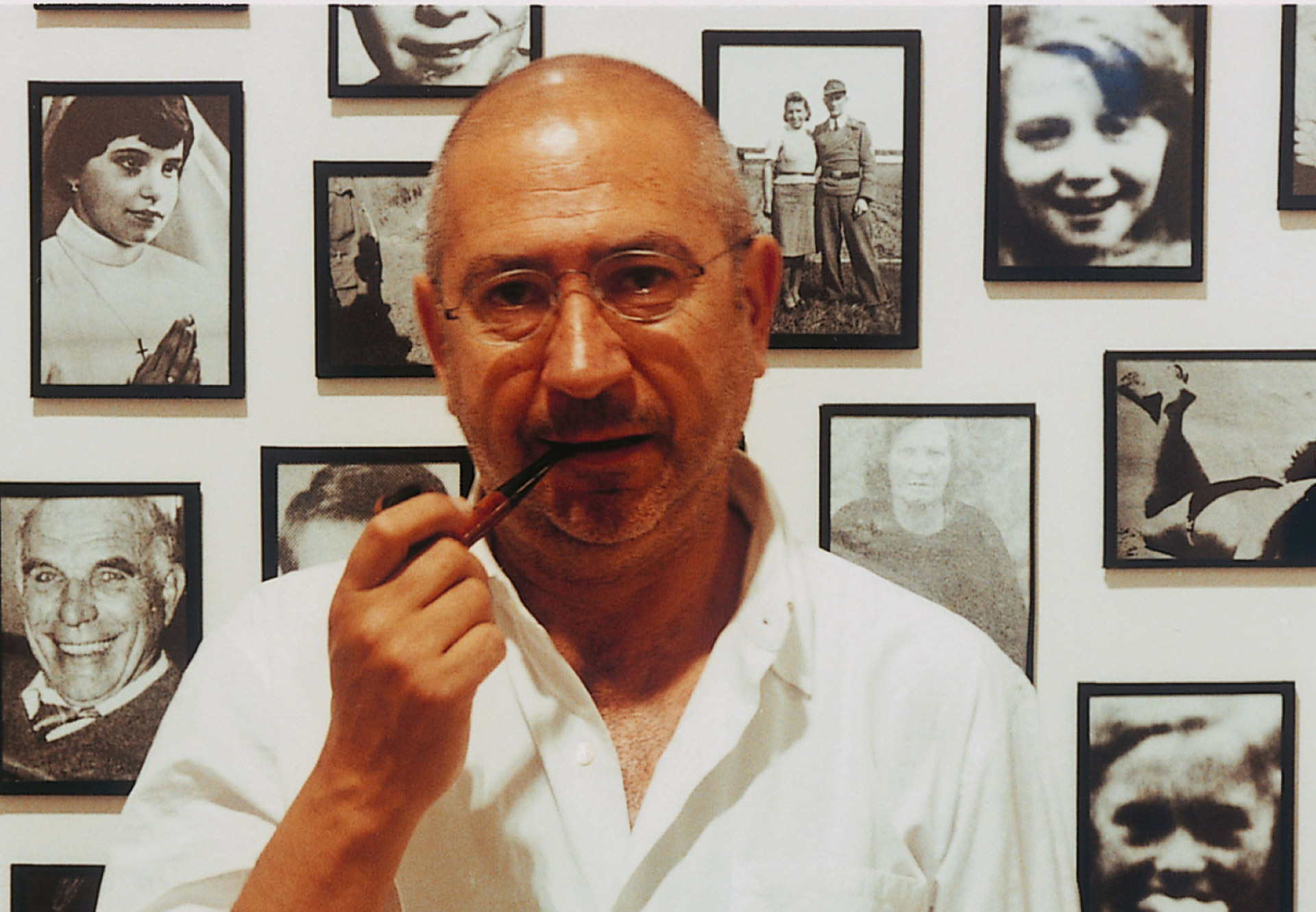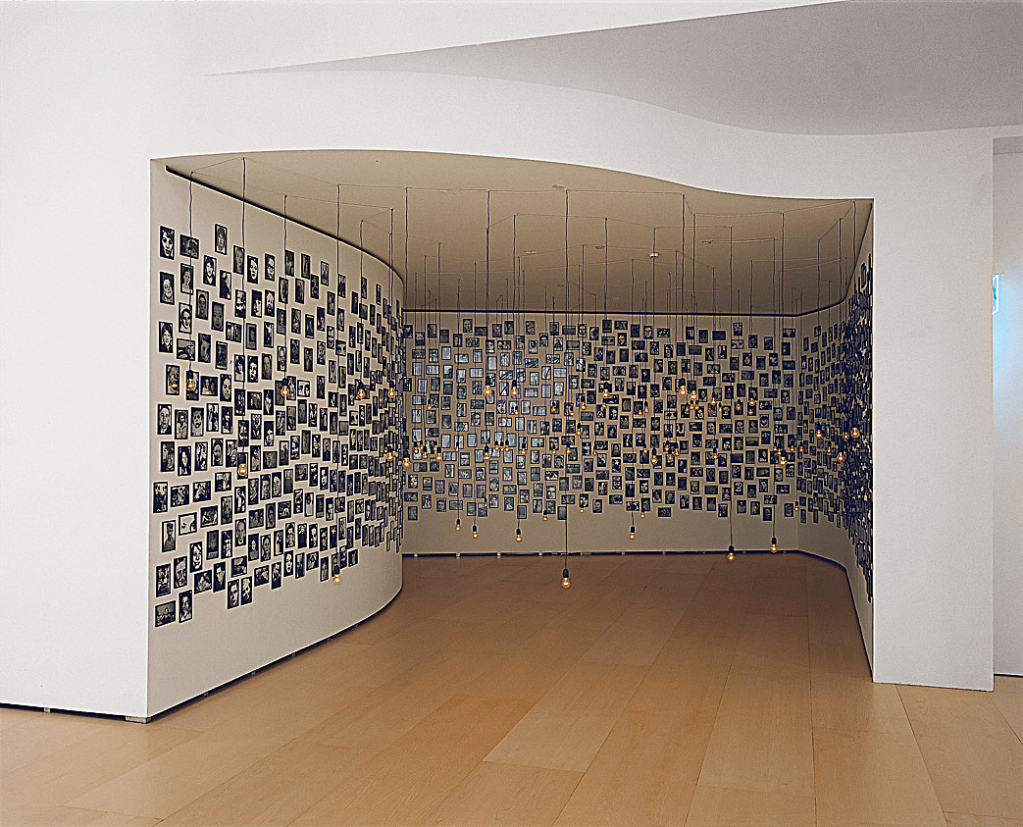Boltanski, Christian
Paris, 1944 | Paris, 2021

19
44
Born on September 6.
Boltanski’s early years are marked by the Nazi occupation of France, which forces his family, who are Jewish, to go into hiding.
58
Begins to paint after a childhood without formal schooling or official training in the arts.
His earliest works are large-format figurative paintings with macabre historical themes.
68
Gives up painting to work with photography as well as materials such as modeling clay, personal artifacts, and postcards, creating works that reflect on life, the passage of time, memory, and his own childhood. Has his first solo exhibition, La vie impossible de Christian Boltanski, at the Théâtre le Ranelagh in Paris.
69
Publishes his first books, Recherche et présentation de tout ce qui reste de mon enfance, 1944–1950 and Reconstitution d’un accident qui ne m’est pas encore arrivé et où j’ai trouvé la mort, both published by Galería Givaudan in Paris.
70
Exhibits at the Musée d’Art Moderne de la Ville de Paris.
72
Takes part in Documenta 5 in Kassel, Germany.
73
The exhibition Les inventaires opens at the Staatliche Kunsthalle Baden-Baden, later traveling to the Israel Museum in Jerusalem, Museum of Modern Art in Oxford, Louisiana Museum for Moderne Kunst in Humlebaek, Denmark, and Centre National d’Art Contemporain in Paris.
75
Takes part in A proposito del Mulino Stucky at the Biennale Architettura di Venezia.
76
The exhibition Photographies couleurs, images modèles is presented at the Musée National d’Art Moderne, Centre Georges Pompidou in Paris.
77
Begins working on the Compositions series.
78
Exhibits at the Institute for Art and Urban Resources, P.S. 1 in New York.
80
The Musée des Beaux-Arts in Calais, France, presents the exhibition Christian Boltanski: Compositions.
84
The show Filme von Christian Boltanski is shown at the Kunsthalle Bern and later travels to the Musée National d’Art Moderne, Centre Georges Pompidou in Paris; Kunsthaus Zürich; Staatliche Kunsthalle Baden-Baden; and Bonner Kunstverein in Bonn.
86
The exhibition Leçon des ténèbres is shown at the Kunstverein München in Munich.
Participates in the XLII Biennale di Venezia.
87
Addresses the theme of the Holocaust at Documenta 8 in Kassel, Germany.
88
The exhibition El caso is presented by the Museo Nacional Centro de Arte Reina Sofía in Madrid.
The exhibition Lessons of Darkness travels to several different museums in the United States and Canada for two years, beginning with the Museum of Contemporary Art in Chicago and closing at the Power Plant in Toronto. The Marian Goodman Gallery in New York organizes an exhibition of Boltanski’s work.
90
Exhibits at the Institute of Contemporary Art in Nagoya, Japan.
Christian Boltanski: Reconstitution opens at the Whitechapel Art Gallery in London and later travels to the Stedelijk Van Abbemuseum in Eindhoven, the Netherlands, and the Musée de Grenoble.
93
The Museum Ludwig in Cologne presents an exhibition of Boltanski’s work.
94
Exhibits at the Museum of Contemporary Art in Oslo.
95
Has solo shows at the Villa Medici in Rome and the Kunsthalle Wien in Vienna.
The exhibition Advento, organized by the Centro Galego de Arte Contemporánea in Santiago de Compostela, Spain, is presented at the church of Santo Domingo de Bonaval in Santiago de Compostela.
97
Exhibits at the National Museum of Contemporary Art in Seoul.
Boltanski’s work is included in The Guggenheim Museums and the Art of This Century, the inaugural exhibition of the Guggenheim Museum Bilbao. The exhibition Recent European Art is also displayed at the same museum.
98
Christian Boltanski: So Far is shown at the Kemper Museum of Contemporary Art and Design in Kansas City.
00
The Museum of Fine Arts in Boston presents Christian Boltanski: Reflexion.
01
The Contemporary Jewish Museum in San Francisco presents the exhibition Face[t]s of Memory: Found Photographs and Family Albums.
Receives the Kaiserring prize from the city of Goslar, Germany, and the Nord/LB, Braunschweig Art Prize later in the year
03
The exhibition The Disembodied Spirit travels to several museums in the United States.
Boltanski’s work is exhibited at Zamek Ujazdowski in Warsaw.
06
The Museo d’Arte Contemporanea Roma in Rome and Institute of Contemporary Arts in London present exhibitions of Boltanski’s work.
Awarded the Praemium Imperiale for sculpture by the Japan Art Association.
07
CAPC, Musée d’Art Contemporain de Bordeaux presents the exhibition Annulé.
08
Magasin 3 Stockholm Konsthall in Stockholm presents an exhibition of Boltanski’s work.
09
The exhibition A mancha is shown at the Centro Galego de Arte Contemporánea in Santiago de Compostela, Spain, and La vie impossible at the Kunstmuseum Liechtenstein in Vaduz, Liechtenstein.
10
The Park Avenue Armory in New York, hosts the exhibition Christian Boltanski: No Man’s Land. Takes part in the exhibitions Collection / Porto: Museu Serralves, at Domaine de Kerguéhennec – Centre d’Art Contemporain in Bignan, France; Contemplating the Void: Interventions in the Guggenheim Museum, at the Solomon R. Guggenheim Museum in New York; and Haunted: Contemporary Photography/Video/Performance, held at the Guggenheim Museum Bilbao.
11
Es Baluard Museu d’Art Modern i Contemporani de Palma in Palma de Mallorca, Spain, presents Signatures, a solo exhibition created specifically for the museum’s Aljub hall.
Represents France at the 54th Biennale di Venezia.
12
Exhibits at the Nahum Gutman Museum of Art in Tel Aviv.
The work presented at the 54th Venice Biennale, Christian Boltanski: Chance, is shown at the Nederlands Fotomuseum in Rotterdam and later on at Casa França Brasil in Rio de Janeiro.
The exhibition Christian Boltanski opens at the Museo de la Universidad Nacional de Tres de Febrero (MUNTREF) in Buenos Aires.
Dança Macabra, a work designed to celebrate the designation of Guimarães as European Capital of Culture 2012, is shown in Fábrica ASA in Guimarães, Portugal.
The expansion of The Heart Archive continues in Helsinki, Rovaniemi, Vaasa and Joensuu, Finland.
13
The Kunstmuseum Wolfsburg, Germany, hosts Moved.
Boltanski sets up Eyes, an installation at the Onassis Cultural Center in Athens.
14
Creates the installation 19.924.458 +/-, shown at SESC Pompeia in São Paulo, Brazil.
Continues expanding The Heartbeat Archive at the Latvian National Museum of Art in Riga.
The Museo Nacional de Bellas Artes in Santiago de Chile and Modern Art Oxford host exhibitions of Boltanski’s works.
15
Exhibits at La Lonja in Palma de Mallorca, Spain; the Musée des arts contemporaines (Mac’s Grand-Hornu) in Hornu, Belgium; MAMbo – Museo d’Arte Moderna di Bologna (Italy), and Cricoteka in Krakow (Poland).
Uncovers a new installation at Galerie Marian Goodman in Paris.
16
Exhibitions are on at the Museo de Arte Contemporáneo de Monterrey (MARCO), the Fundação Árpád Szenes – Vieira da Silva in Lisbon, the Institut Valencià d’Art Modern (IVAM) in Valencia, Jupiter Artland in Edinburgh, and the Tokyo Metropolitan Teien Art Museum.
17
Creates the installation NA at the Oude Kerk in Amsterdam (The Netherlands). The installation Les Registres du Grand-Hornu is exhibited at El Instante Fundación in Madrid.
The Espace Louis Vuitton in Munich (Germany), the National Museum of Fine Arts in Buenos Aires (Argentina), and MAMbo – Museo d’Arte Moderna di Bologna (Italy), host solo exhibitions by the artist.
18
Exhibitions of his work are hosted at the Israel Museum in Jerusalem and the Power Station of Art in Shanghai. Marian Goodman Gallery in London and Librairie Marian Goodman in Paris show Boltanski’s artworks.
19
Christian Boltanski: Lifetime opens at the National Museum of Art in Osaka, Japan. The exhibition then travels to the National Art Center in Tokyo and the Nagasaki Prefectural Art Museum.
Installs Animitas at Espace Louis Vuitton Tokyo and at the Hellbrunn SkulpturenPark in Salzburg, Austria. The installation had been introduced in 2014 in the Atacama Desert, Chile.
Christian Boltanski: Faire son temps is staged at the Centre Pompidou in Paris. In it, the artist reviews his career in fifty works.
20
Unveils his installation Chance at the Images Vevey Festival in Switzerland. The installation had been part of the French Pavilion at the 54th Venice Biennale. Now it was reinterpreted for the Swiss festival.
21
Solo exhibition at the Busan Museum of Art in South Korea.
Animitas installed at the Noguchi Museum in New York.
Dies in Paris. Hommage à Christian Boltanski (1944-2021) is staged at Versailles, the Centre Pompidou, the Louvre Museum, and the Opéra-Comique to celebrate his life and work.
22
His work is part of Sections/Intersections. 25 Years of the Guggenheim Museum Bilbao Collection, an exhibition of works from the Museum Collection staged to celebrate the Museum’s 25th anniversary.

